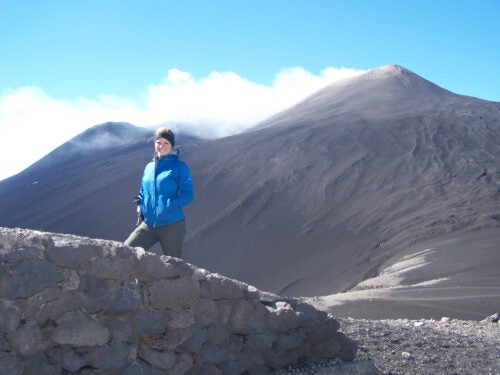
Boise State Associate Professor Brittany Brand from the Department of Geosciences recently secured two hazard and risk-related grants totaling more than $1 million from the National Science Foundation (NSF). The two grants explore diverse concepts related to hazards, risk and preparing for future natural disasters – from the science of disasters to the psychology behind disaster response.
“The overall theme of my research is understanding and reducing our risk to natural hazards,” said Brand.
The volcanology project, led by Brand and Department of Geosciences Assistant Professor Dorsey Wanless, is titled “When Good Volcanoes go Bad: Exploring the Magmatic, Crustal, and Conduit Conditions Required for Mafic, Plinian Volcanism.” This project received a $519,000 grant from NSF programs within the Division of Earth Sciences.
Brand, Wanless and two Boise State Ph.D. students will explore how volcanoes that typically produce mild activity may suddenly shift behavior, resulting in devastating, explosive eruptions.
Mafic magma tends to be more fluid, allowing gas that could drive explosive eruptions to escape. As such, mafic volcanoes — the most common kind on earth — tend to ooze lava or have mild explosive activity. However, sometimes these tame volcanoes erupt more explosively. The summit eruption of Kilauea in Hawaii is one recent real-world example.
“What causes the shift in volcanic activity remains poorly understood,”said Brand. But the new study will use diverse methods in an attempt to find the reason.

The project will focus on Volcán Llaima, a mafic, active volcano in Chile that has produced eruptions of lava, but also several highly explosive events. “The findings will have global implications for the millions of people living at risk from mafic volcanic centers including the currently active Kilauea volcano in the USA,” said Brand.

The public and academic community will be able to follow the team’s progress on the Boise State Magmatic and Volcanic Studies group Facebook page.
Brand’s own experiences in Chile in 2015 — being awakened in the night by an erupting volcano and seeing first-hand the effect of inadequate public education about hazards and preparedness — spurred her interest in the topic of preparedness psychology and effective science communication. This inspired the idea for the second funded project, based in risk perception and preparedness, which received a $536,000 grant from the NSF program Humans, Disasters, and the Built Environment. The project is titled “Assessing the Influence of Cultural Variables, Perceptions, and Earthquake Hazard Information on Household Emergency Preparedness.”

”This project is more about the social side of hazards,” said Brand. “Once we know the dangers, how do we share hazard and risk information with at-risk citizens in a way that motivates them to take preparedness actions?”
This research includes a team of social scientists and two Boise State Ph.D. students to learn how people prepare for emergency events, explore the best strategies to convey hazard information, and ultimately reduce the loss of property, lives and the cost of recovery.
Brand co-founded the Natural Hazards, Risk and Resiliency Consortium (NHRRC) on campus in 2017 to promote research collaborations across campus and to ensure research efforts have a local impact. The NHRRC is a multidisciplinary group of researchers and practitioners whose mission is to improve society’s resilience to natural hazards and the impacts of climate change. The group collaborates with community stakeholders including emergency managers, public health experts, K-12 educators and others.

Brand also teaches “Natural Hazards, Risk and Resiliency” in the Honors College and the university foundations course “(Un)Natural Disasters …” (co-taught with Jen Pierce).
“Making sure our research efforts have a direct societal impact is incredibly important,” said Brand. “We must work directly with community members and stakeholders to both ensure our research efforts have a practical impact, and to communicate our findings in a way that motivates societal changes that reduce our risk to future natural (and unnatural) hazardous events.”